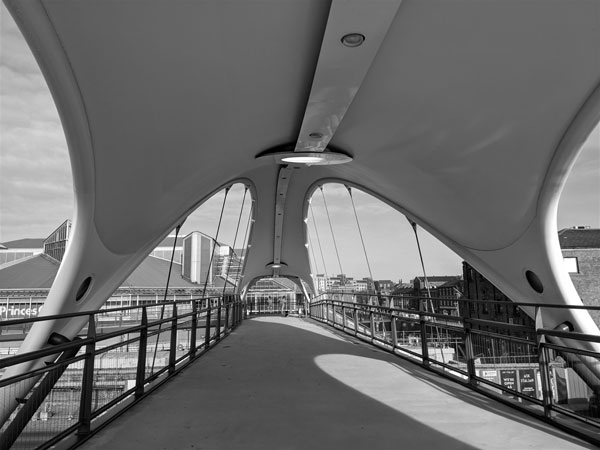SSDA Awards
COMMENDATION: Murdoch’s Connection

Named in honour of the city’s first female GP, a new bridge forms an important element in Hull’s plan to improve connectivity between the city centre and the southern waterfront.
FACT FILE
Architect: Matter Architects
Structural engineer: Arup
Steelwork contractor: S H Structures Ltd
Main contractor: Tilbury Douglas Construction
Client: Highways England
With a span of 40m (54m long including cantilever ends) Murdoch’s Connection is named after Dr Mary Murdoch, Hull’s first female GP and is said to be one of the most important elements in Hull City Council’s (HCC) masterplan for joining the north of the city centre to the vibrant southern waterfront.
Crossing the busy A63, the pedestrian bridge has been funded by the Humber Local Enterprise Partnership and Highways England. Recognising the long-term role of the bridge within a developing city centre, the design makes passive allowances for future connections to adjacent areas as well as lifts and retail spaces underneath.
The bridge and approaches have been designed to fulfil dual functions of providing a crossing point, but also as places to connect with the historic parts of the city. The bridge deck widens from 4m to 6m, and viewing platforms are provided at both ends of the deck overlooking the docks. The landscaped approaches incorporate seating and spaces for reflection and recreation. Surrounding the site are severally historically significant features that the design has carefully incorporated to ensure that this modern structure connects with its setting.

The steel superstructure of the bridge has a hybrid shell form with a conventional tied arch formed of steel circular sections and an integrated structural canopy acting compositely with the perimeter tubes. Below the deck, the perimeter tubes transition through ‘arch-feet’ units, which gather the arch forces and transfer them through to the substructure on piled foundations.
The sections of the double curved shell were formed using special plate bending techniques. Ergonomics of the design were tested primarily through the detailed digital model of the structure, but due to its unusual shape, the hidden drainage hoppers at the entrances were also modelled in plywood to test accessibility for maintenance.
Digital rehearsals in the design office, early engagement by the construction team and fabricators, and the use of templating of ‘as-built’ positions are said to have ensured a seamless sequence of works.
Construction methods were chosen to minimize the impact on the public. For instance, the bridge structure was driven into place on specialist transporters rather than craned in to avoid road closures affecting the travelling public. This move was completed 16 hours ahead of schedule without any complaints from the public.
In summary, the judges say this new bridge provides a welcome crossing over a busy inner-city road. The unusual, sculpted form uses pressed steel plates that connect the tubular structure together resulting in a complex geometric ‘roof’ to the bridge. This is not just a bridge but an integral part of a new urban public space.









